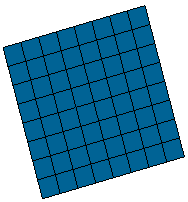This test lets you check analysis results for a simply-supported thin square plate, in the context of a transient dynamic response case. You will use 2D meshes.
This test is used to validate the following attributes:
-
2D shell elements (i.e. the elementary stiffness and mass matrices)
-
Transient dynamic response solve algorithms.
Reference:
NAFEMS-Glasgow, Benchmark newsletter, Report No. E1261/R002, p.21, February 1989.
 Specifications
Specifications
Geometry Specifications
|
Length: |
|
|
Thickness: |
Analysis Specifications
|
Young Modulus (material): |
|
|
Poisson's Ratio (material): |
|
|
Density: |
|
|
Restraints: Tx = Ty = Rz = 0
at all nodes |
|
|
|
 Results
Results
You will find here the results for different finite elements:
|
Type of values |
Reference solution |
Values |
|||||||
|
Linear triangle shell |
Parabolic triangle shell |
Linear quadrangle shell |
Parabolic quadrangle shell |
||||||
|
|
|
|
|
||||||
|
Values |
Error |
Values |
Error |
Values |
Error |
Values |
Error |
||
|
Peak displacement [mm] |
3.523 |
3.444 |
2.24 |
3.445 |
2.21 |
3.451 |
2.04 |
3.446 |
2.19 |
|
Peak stress [MPa] |
2.484 |
2.221 |
10.59 |
2.217 |
10.75 |
2.251 |
9.38 |
2.234 |
10.06 |
|
Static displacement [mm] |
1.817 |
1.774 |
2.37 |
1.775 |
2.31 |
1.776 |
2.26 |
1.775 |
2.31 |
To Perform the Test:
The Transient_forced_vibration_of_a_simply_supported_thin_square_plate.CATAnalysis document presents a complete analysis of this case, computed with a mesh formed of linear quadrangle elements (QD4).
To compute the case with parabolic quadrangle (QD8), linear triangle (TR3) and parabolic triangle (TR6) elements, proceed as follow:
-
Open the CATAnalysis document.
-
In the Advanced Meshing Tools workbench, replace the mesh specifications as indicated above.
-
In the Generative Structural Analysis workbench, compute the case.

